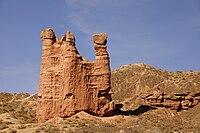
Photo from wikipedia
The oasis, a special landscape with the integration of nature and humanity in the arid region, has undergone an enormous transformation during the past decades. To gain a better understanding… Click to show full abstract
The oasis, a special landscape with the integration of nature and humanity in the arid region, has undergone an enormous transformation during the past decades. To gain a better understanding of the tradeoff between economic growth and oases stability in the arid land, we took the oases in the Hexi Corridor as a case to explore the constraints of oases development and the driving factors of oases expansion. The dynamic changes and spatial distribution patterns underwent by the oases were examined using multispectral remote sensing imagery. The constraints of oasis development in arid land were investigated by the grid-transformed model, as well as the index system of driving forces was analyzed using the grey incidence model based on the data from statistics yearbooks. The oasis area in the Hexi Corridor had tremendous changes expanded 40% from 1986 to 2015, the stable oasis area was 9062 km2, while the maximum area reached 16,374 km2. The constraints for oases of topography, hydrology and heat condition are as follow: The elevation of oasis ranged from 1000 to 1800 m, peaked in 1500 m; the slope of oasis distribution was flatter than 3 degrees; the aspect of oases on slope land concentrated in northeast and north, accounting for more than 60%. The main driving forces of oasis spatial expansion in the arid region were population, water resource, economy, policies, and other factors. These results are expected to (1) improve the rationality of oasis development, and (2) promote the sustainable planning and management of oases in the arid land.
Journal Title: Scientific Reports
Year Published: 2020
Link to full text (if available)
Share on Social Media: Sign Up to like & get
recommendations!